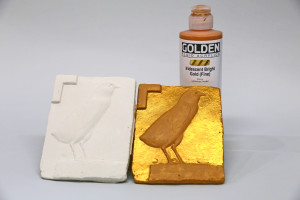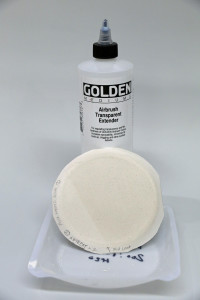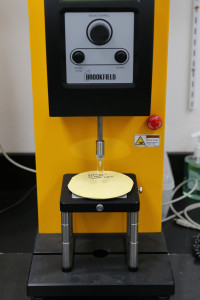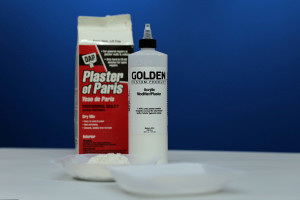
Plaster has been decorated with paint since its earliest known usage back in 7500 B.C. Jordan. The rather simple mixture of lime powder, crushed limestone and water was used to achieve smooth walls for interior wall decoration. Ancient Egyptian builders employed calcined (heated) gypsum into their plaster, which improved the functional use. The duel use of form and function is evidenced by their opulent palaces and tombs, including the pyramids of Giza. The term “Plaster of Paris” originates from 15th century Montmartre, France – the source for its prized hemihydrated calcium sulfate. Of course other sources are now known, but this specific vein of gypsum was proven to be an extremely important component for mold-making and casting and the name is now synonymous with plaster. Traditionally shellac is used as a plaster sealer, but this article focuses on using waterborne acrylics for both sealing and painting.

Before painting plaster, it is important to allow the material to become fully dry. This process may take up to a month, so follow the plaster manufacturer’s recommendations on curing time. Ultimately, the plaster needs to be very dry in order for the initial priming layers to properly bond to the plaster surface. Drying rooms or low temperature ovens expedite the drying rate for objects.
Acrylics are alkaline in the wet state and adhere well to plaster. However, the surface of cast plaster is usually smooth and thicker paints often cannot penetrate deep enough to create a strong bond. Therefore, thin products are better suited as the initial coats. Uncoated plaster is extremely absorbent and allows thin products to penetrate deeply and seal the surface, thus paving the way for the next layer. This is the key to painting with acrylics onto plaster. Allow time for each layer to sufficiently dry. An indicator of this is the plaster darkens while wet, and then lightens as it dries. As each coat continues sealing the surface, the plaster remains a bit darker . Once the surface is sealed, thicker products such as Fluid Acrylics or Heavy Body Acrylics can be used.
GOLDEN High Flow Acrylics may be applied directly to unsealed plaster. These paints readily absorb into the plaster. The negative side effect is akin to staining raw wood; the color tends to be somewhat blotchy and uneven.

Woodworkers remedy this with a pre-stain conditioner. A ready to use, suitable conditioner for plaster is GOLDEN Airbrush Transparent Extender. This thin acrylic medium is applied directly to the plaster surface. Two or more coats create a less absorbent and more uniform paint layer. Certainly other products may be used (GAC 800 is an excellent coating for chalky surfaces), provided they are sufficiently thin enough to readily absorb into the plaster. High Flow Acrylics were compared to Fluid Acrylics on bare plaster and both absorbed readily with excellent adhesion. These paints are thin enough to not cover up casting details. GOLDEN Heavy Body Acrylics can be used on a properly sealed surface, but they will retain more brush and tool marks.
Acrylic paint may also be added into the plaster slurry to tint the cast object. This is a useful coloring method because, unlike surface painted plaster, chipped areas will not be as noticeable. Adding acrylic paints or medium may also improve the overall plaster strength because they form a network within the plaster. The concept of adding acrylic to strengthen plaster is not a new idea. GOLDEN Custom Product “Acrylic Modifier for Plaster” was developed around 1990 to improve the overall strength and chip-resistance of cast objects by integrating a matrix of acrylic polymers within the cast object. The liquid additive is mixed with water prior to adding the powdered plaster, usually between 3-10% of the weight of plaster used. At a 10% level, our limited testing revealed that the Acrylic Modifier for Plaster increases the amount of force required to break ordinary Plaster of Paris by 50% and increases the amount of force required to break USG’s Hydrostone by 25% . Hydrostone is a stronger and more durable plaster to begin with, so this increase is noteworthy. Adding acrylic into the plaster also reduces absorbency, thereby reducing the number of sealing coats required prior to painting. However, acrylic additions will also slow the curing time down, which can be an issue for some applications.

Once the plaster objects have been painted, they may be top-coated with a variety of materials, including GOLDEN Polymer Varnish, MSA Varnish or Archival Spray Varnish for decorative and artistic needs. Commercial topcoats should be used for more demanding functional requirements. Exterior use demands the use of waterproof coatings such as two-part automotive urethanes.
As always, if you have any questions about this application, please contact the Material Specialists in our Technical Support Department.
